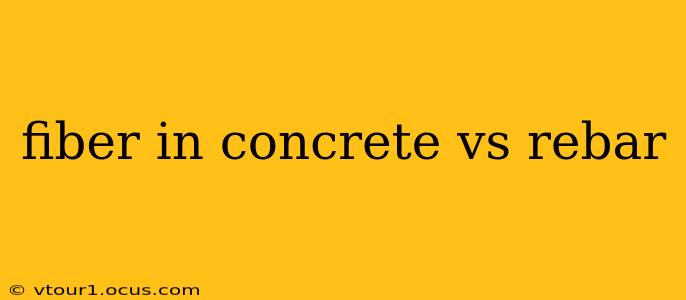Reinforcement in concrete is crucial for enhancing its strength and durability. While steel rebar has long been the standard, fiber reinforcement is gaining traction as a viable alternative and even a complementary technology in many applications. This article will delve into the key differences between fiber reinforcement and rebar, exploring their respective strengths and weaknesses to help you understand which is best suited for your project.
What is Rebar?
Rebar, short for reinforcing bar, consists of steel bars placed within concrete structures to provide tensile strength. Concrete is excellent in compression, but weak in tension. Rebar counteracts this weakness, allowing concrete to withstand bending and cracking forces. The diameter and spacing of rebar are carefully calculated based on structural engineering principles to ensure adequate reinforcement for the intended load.
Advantages of Rebar:
- High Tensile Strength: Rebar offers exceptional tensile strength, making it highly effective in resisting cracking and structural failure.
- Established Technology: It's a well-understood and widely accepted technology with extensive design codes and industry experience.
- Ductility: Rebar can deform under stress without immediately breaking, providing some warning before complete failure.
Disadvantages of Rebar:
- Corrosion: Rebar is susceptible to corrosion, especially in harsh environments with moisture and chloride ions. This can significantly weaken the concrete structure over time.
- Labor Intensive: Installing rebar is labor-intensive, requiring skilled workers and careful placement.
- Cost: The cost of materials and labor associated with rebar can be substantial, especially in large-scale projects.
- Potential for Cracking: While rebar strengthens concrete, it doesn't prevent cracking entirely; it merely manages the extent of cracking.
What is Fiber Reinforcement in Concrete?
Fiber reinforcement uses short, discrete fibers dispersed throughout the concrete mix. These fibers can be made from various materials, including steel, polypropylene, glass, and carbon. They improve the concrete's tensile strength, toughness, and resistance to cracking by bridging cracks and preventing their propagation.
Advantages of Fiber Reinforcement:
- Improved Crack Control: Fibers significantly reduce the size and spacing of cracks, enhancing the durability and aesthetics of the concrete.
- Increased Toughness: The concrete becomes more resistant to impact and abrasion.
- Enhanced Workability: Fibers can improve the workability of the concrete mix, making it easier to place and finish.
- Reduced Shrinkage: In some cases, fibers can reduce shrinkage cracking.
- Faster Construction: The ease of incorporation and reduced need for complex placement makes construction faster.
Disadvantages of Fiber Reinforcement:
- Lower Tensile Strength (compared to rebar): While fibers improve tensile strength, they generally don't reach the same level as rebar for heavy-duty applications.
- Material Specific Performance: The performance of fiber-reinforced concrete depends heavily on the type of fiber used, its properties, and the concrete mix design.
- Limited Applicability: Fiber reinforcement is generally more suitable for applications where high tensile strength isn't the primary concern, such as pavements, shotcrete, and some structural elements.
Fiber in Concrete vs. Rebar: Which is Better?
The "better" option depends entirely on the specific application. There is no universally superior choice.
- For high-strength, heavy-duty structural elements (e.g., columns, beams in high-rise buildings): Rebar remains the preferred choice.
- For applications requiring enhanced crack control, impact resistance, and improved durability (e.g., pavements, shotcrete, industrial floors): Fiber reinforcement provides significant advantages.
- Hybrid Approach: In many instances, a combination of rebar and fiber reinforcement offers optimal performance. Fibers can supplement rebar, minimizing cracking and enhancing durability, while rebar provides the primary tensile strength.
What are the different types of fibers used in concrete?
Several types of fibers are used to reinforce concrete, each with its own properties and applications:
- Steel Fibers: Offer high tensile strength and are suitable for demanding applications.
- Polypropylene Fibers: Provide good crack control and are commonly used in pavements and industrial floors. They are also more resistant to corrosion than steel.
- Glass Fibers: Offer moderate strength and are often used for their ease of handling and relatively low cost.
- Carbon Fibers: Exhibit very high strength-to-weight ratios but are typically more expensive.
What is the cost difference between using fiber and rebar?
The cost difference varies depending on factors such as the type of fiber, the amount needed, labor costs, and the scale of the project. In general, fiber reinforcement often has lower material costs than rebar, but the total cost might be comparable or even slightly higher due to potential adjustments needed to concrete mix designs and placement techniques.
Is fiber reinforced concrete suitable for all structural applications?
No, fiber-reinforced concrete is not suitable for all structural applications. While it offers advantages in many areas, it generally doesn't provide the same level of tensile strength as rebar in heavier structural applications. The choice depends on careful consideration of the structural requirements and the specific properties of the chosen fiber type.
By carefully evaluating the project's specific requirements, engineers can select the optimal reinforcement method—whether it's rebar, fiber reinforcement, or a hybrid approach—to ensure the structure's safety, durability, and longevity.
